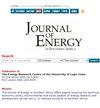Reclamation of ultra-fine coal with scenedesmus microalgae and comprehensive combustion property of the Coalgae® composite
IF 0.6
4区 工程技术
Q4 ENERGY & FUELS
引用次数: 4
Abstract
Combustion of South African discard ultra-fine coal (i.e. coal dust), charcoal, microalgae biomass, and composites of the three under air were studied. The study involves to find out the effect of Scenedesmus microalgae biomass on the comprehensive combustion characteristics of the ultra-fines. Coal dust is considered as waste material, but it could be modified and combusted for energy. The composites were designed with Design Expert, and unlike blending with the dry microalgae biomass, fresh slurry was blended with the ultra-fine coal and charcoal. Non-isothermal combustion was carried out at heating rate of 15 C/min from 40 – 900 oC and at flow rate of 20 ml/min, O2/CO2 air. Combustion properties of composites were deduced from TG-DTGA and analysed using multiple regression. On combustion, the interaction of coal-charcoal-microalgae was antagonistic (b = - 1069.49), while coal-microalgae (b = 39.17), and coal-charcoal (b = 80.37), was synergistic (p = 0.0061). The coal-microalgae (Coalgae®) indicated first order reaction mechanism unlike, coal, and the charcoal. Comprehensive combustion characteristics index of Coalgae®, (S-value = 4.52E8) was superior relative to ultra-fine (S-value = 3.16E8), which indicated high quality fuel. This approach to combusting ultra-fine coal with microalgae biomass is partly renewable, and it would advance the production of heat and electricity. Key words: coal-dust, combustion, s-value, Coalgae®, renewable.微藻对超细煤的回收及Coalgae®复合材料的综合燃烧性能
研究了南非废弃超细煤(即煤尘)、木炭、微藻生物质及其复合材料在空气中的燃烧情况。研究了微藻生物量对超细颗粒燃料综合燃烧特性的影响。煤尘被认为是废物,但它可以被改造和燃烧为能源。复合材料由Design Expert设计,与干燥微藻生物质混合不同,新鲜浆料与超细煤和木炭混合。在40 ~ 900℃的升温速率为15℃/min, O2/CO2空气流量为20 ml/min的条件下进行非等温燃烧。利用TG-DTGA法推导了复合材料的燃烧性能,并用多元回归分析了复合材料的燃烧性能。在燃烧方面,煤-炭-微藻的相互作用为拮抗作用(b = - 1069.49),煤-微藻(b = 39.17)与煤-炭(b = 80.37)的相互作用为协同作用(p = 0.0061)。煤微藻(Coalgae®)具有不同于煤和木炭的一级反应机理。Coalgae®的综合燃烧特性指数(s值= 4.52E8)优于超细粉(s值= 3.16E8),为优质燃料。这种用微藻生物质燃烧超细煤的方法在一定程度上是可再生的,它将促进热能和电力的生产。关键词:煤尘,燃烧,s值,Coalgae®,可再生能源
本文章由计算机程序翻译,如有差异,请以英文原文为准。
求助全文
约1分钟内获得全文
求助全文
来源期刊

Journal of Energy in Southern Africa
ENERGY & FUELS-
CiteScore
3.00
自引率
0.00%
发文量
16
审稿时长
6 months
期刊介绍:
The journal has a regional focus on southern Africa. Manuscripts that are accepted for consideration to publish in the journal must address energy issues in southern Africa or have a clear component relevant to southern Africa, including research that was set-up or designed in the region. The southern African region is considered to be constituted by the following fifteen (15) countries: Angola, Botswana, Democratic Republic of Congo, Lesotho, Malawi, Madagascar, Mauritius, Mozambique, Namibia, Seychelles, South Africa, Swaziland, Tanzania, Zambia and Zimbabwe.
Within this broad field of energy research, topics of particular interest include energy efficiency, modelling, renewable energy, poverty, sustainable development, climate change mitigation, energy security, energy policy, energy governance, markets, technology and innovation.
 求助内容:
求助内容: 应助结果提醒方式:
应助结果提醒方式:


